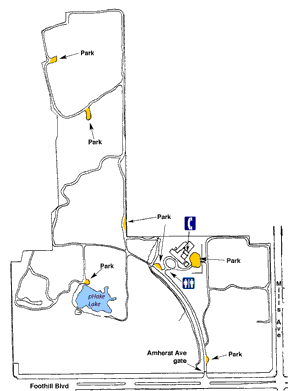
The Robert J. Bernard Biological Field Station of the Claremont Colleges (the BFS) is a common-use facility of the Claremont University Consortium (CUC). The station is currently managed by the BFS Director, who reports to CUC and is advised by a Faculty Advisory Committee. The mission of the BFS is to provide facilities and ecological communities for high-quality teaching and research experiences in the biological, environmental, and other sciences, to the students, faculty, and staff of the Claremont Colleges.
The BFS is used for teaching and research by faculty, staff, and students of the Claremont Colleges. However, use of the Station is not a right belonging to anyone; it is a privilege whose exercise is subject to compliance with the standards established herein for its use. All users must respect and not interfere with the uses and projects of others. Deliberate or egregious interference with the work of others is grounds for denial of use privileges.
BFS use must be shared among the members of the Colleges community. All projects on the BFS must be approved, and uses must be communicated to and coordinated with the BFS Director. To apply to use the BFS for a project, please use the on-line request form, which will submit your request to the Director. Please note that use of limited facilities (e.g., pHake Lake or the outdoor classroom) is scheduled on a first-come, first-served basis.
Teaching and research projects on the BFS should generally use non-destructive techniques, and non-destructive projects are routinely approved by the Director within a few days. Certain projects, as noted below, will also need to approved the Faculty Advisory Committee, or other Committees or agencies. These approvals may take several weeks, so apply well in advance.
As a matter of policy, collecting is not allowed on the Station; in particular, killing vertebrate species is prohibited because they exist at much smaller population sizes than invertebrates or plants. Exceptions to this policy must be approved in advance by the Faculty Advisory Committee.
The BFS, however, is not a nature preserve, and manipulative experiments are explicitly allowed, as long as they do not compromise the biological integrity of the Station or jeopardize the work of others. Manipulative and/or destructive experiments must be coordinated with the Director and approved by the Faculty Advisory Committee, and specific sites must be identified, so as not to conflict with other uses.
Note that any experiments involving vertebrate animals must be approved by the appropriate institutional Animal Care Committee. Any experiments involving Federally listed “Threatened” or “Endangered” species must be approved by U.S. Fish & Wildlife.
Non-teaching and non-research uses by the Claremont Colleges community must be approved by the BFS Director. Any use that the Director feels is questionable will be referred to the Faculty Advisory Committee.
The BFS is normally accessed via the gates at Amherst Avenue along Foothill Blvd, which are equipped with combination locks. The “student lock” on the pedestrian gate is for class use, and its combination will change every semester. The lock on the vehicle gate across the entrance road is for use by faculty, staff, and outside agencies (such as the Fire Department, Vector Control, and the Department of Fish & Game). Its combination will change annually. Other points of access may only be used by authorization of the Director.
The use of motor vehicles on the BFS is strongly discouraged. In particular, students are not permitted to drive onto the Station unless their projects or coursework require the transportation of people with limited mobility or equipment too unwieldy to be carried by hand. If vehicles must be used, they must stay on the roads. Driving through or over native vegetation is not allowed under any circumstances.
Parking is a particular concern. Parking is not allowed on native vegetation, on any paved surface within the Station, in front of the Amherst gate, or on any of the cleared unpaved roadways in a manner that blocks the passage of emergency vehicles. All roadways on the Station are fire lanes, and must be kept clear at all times. Parking should be at the HQ (behind the Infirmary), or alongside of roads in places shown on the map below, such that a fire truck can pass by unhindered.
Instructors are responsible for introducing students to the BFS and explaining access and use policies. All students using the Station should be given a copy of the BFS Student Use Rules. The prohibition of recreational use and the restrictions on vehicles and parking should be particularly emphasized.
Many kinds of use of the BFS involve establishing marked locations or marking animals. A description of marks (flags, tags, etc.) should be provided to the BFS Director on the Use Request Form. These descriptions will be posted on the Submitted Projects page. Each Project Request is assigned a unique Request No., which is e-mailed to the requestor and posted on the Projects page. All flags and tags are to be marked with the last four digits of this number. It is the responsibility of all users to respect marked study sites of others. All marks, flags, etc. must be removed at the conclusion of studies (an exception to this may be for marked animals and plants that might be used for future studies, provided that a complete accounting for marks is provided to the BFS Director).
No species may be introduced to the BFS without written approval from the Dw, the Faculty Advisory Committee, and CUC.
Approved January 17, 2002
by the BFS Faculty Advisory Committee